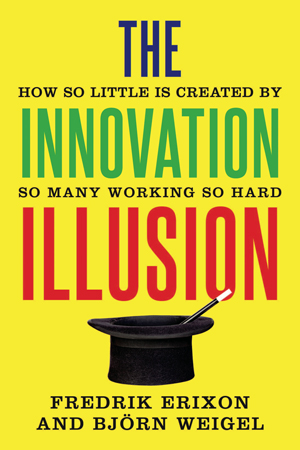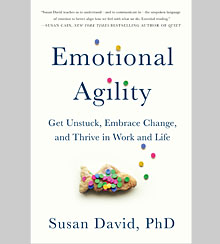strategy+business, November 23, 2016
by Theodore Kinni
Wednesday, November 23, 2016
How to Get Off the Hook
Posted by
Theodore Kinni
at
5:59 PM
0
comments
![]()
Labels: bizbook review, change management, corporate life, corporate success, human resources, leadership, management, personal success, strategy+business, work
Why Innovation Isn’t Enough
MIT Sloan Management Review, November 23, 2016
by Theodore Kinni
 Artificial intelligence, robotics, blockchains, reusable rockets, self-driving cars, genetic engineering — there is an unprecedented explosion of innovation going on all around us, and nowhere is it creating more froth than in the corporate sphere. And yet, as Fredrik Erixon and Björn Weigel point out in their new book, The Innovation Illusion: How So Little Is Created by So Many Working So Hard (Yale University Press, 2016), GDP growth, productivity, and corporate investment in the capitalist economies of the West are all on the decline.
Artificial intelligence, robotics, blockchains, reusable rockets, self-driving cars, genetic engineering — there is an unprecedented explosion of innovation going on all around us, and nowhere is it creating more froth than in the corporate sphere. And yet, as Fredrik Erixon and Björn Weigel point out in their new book, The Innovation Illusion: How So Little Is Created by So Many Working So Hard (Yale University Press, 2016), GDP growth, productivity, and corporate investment in the capitalist economies of the West are all on the decline.Erixon and Weigel, both of the European Centre for International Political Economy, an economic think tank, peg this counterintuitive reality to “gray capitalism, excessive corporate managerialism, second-generation globalization, and complex regulations.” They contend that these “Four Horsemen of capitalist decline” have rendered large companies moribund and risk-averse, and thus have produced an environment in which innovation flourishes, but never generates a full measure of economic output.
In the following excerpt, the authors remind us that while innovations may produce unicorns that enrich founders and VCs, they can’t drive broad-based economic progress on their own. Read the excerpt here.
Posted by
Theodore Kinni
at
10:08 AM
0
comments
![]()
Labels: books, business history, corporate success, creativity, entrepreneurship, innovation, leadership, management
Thursday, November 10, 2016
TechSavvy: Is Your Company Winning the Race to Digital Transformation?
 MIT Sloan Management Review, November 10, 2016
MIT Sloan Management Review, November 10, 2016
by Theodore Kinni
In some respects, the digitization of business is a pretty nebulous subject. It’s not like a company achieves digital transformation on some specific date — the darn target moves as new technologies and applications appear. That’s one reason why Jane McConnell’s 10th annual inquiry into “The Organization in the Digital Age” is worth a look.
McConnell frames digital transformation as an organizational imperative that manifests itself in three dimensions: people, workplace, and technology. Over the past decade, she has been gauging the progress that a broad, international group of 300+ companies and other institutions has been making toward this imperative in three stages.
The Starting stage is defined by an individual (rather than organizational) digital awareness — digital initiatives are ad hoc and infrequent; senior leaders are minimally involved; most decisions are made by traditional hierarchy; work mainly takes place in established channels, with some virtual venues. The Developing stage is defined by mobilization — a compelling vision for digital transformation exists; senior managers are leading the charge; most functions, levels, and entities are involved in digital initiatives. The Maturing stage is defined by trust — digital is considered a strategic asset; it is embedded in work practices; much decision making is decentralized; information and collaboration is organization-wide and includes customers and external partners.
“The 2016 data shows 16% of the survey participants in the Maturing stage, 52% in the Developing stage, and 32% in the Starting stage,” McConnell reports. Where does your company place? Read the rest here.
Posted by
Theodore Kinni
at
10:25 AM
0
comments
![]()
Labels: articles to ponder, blockchain, change management, competitive intelligence, corporate success, data science, digitization, entrepreneurship, innovation, leadership, TechSavvy
Wednesday, November 9, 2016
Margaret Heffernan’s Required Reading
strategy+business, November 9, 2016
by Theodore Kinni
By 2100, we are going to eradicate disease and colonize Mars. In a time when it can be hard to tell corporate leaders from sci-fi writers, Margaret Heffernan speaks more to achieving lofty visions than announcing them. The author, speaker, and executive coach is particularly interested in how to identify and empower talented people — a key trait of effective executives, whether they are bound for Mars or not.
Heffernan, a journalist by training, has written extensively on the theme of talent. In The Naked Truth: A Working Woman’s Manifesto on Business and What Really Matters (Jossey-Bass, 2004) and Women on Top: How Women Entrepreneurs Are Rewriting the Rules of Business Success (Viking, 2007), she examined the costs of undervaluing women in the workplace. In Willful Blindness: Why We Ignore the Obvious at our Peril (Walker & Company, 2011), Heffernan explored how having the right team can save leaders from catastrophic blind spots. In A Bigger Prize: How We Can Do Better than the Competition (Public Affairs, 2014), she explained why more inclusive, collaborative cultures outperform competitive ones. Most recently, Heffernan reprised her popular TED talks in Beyond Measure: The Big Impact of Small Changes (Simon & Schuster/TED, 2015), a short book that describes the powerful, positive effects that result from minor alterations in how we work together.
When I invited Heffernan to talk books, she quickly agreed. “I mentor a handful of senior and chief executives, and the ones that read a lot have so many more choices in their heads than those who don’t. So, I say read, read, read, read, and read some more,” she said, and offered up the following four titles. Read the rest here.
Posted by
Theodore Kinni
at
9:54 AM
0
comments
![]()
Labels: books, corporate life, corporate success, creativity, human resources, leadership, management, org culture, personal success, Required Reading, strategy+business, work, writing
Tuesday, November 8, 2016
How to Develop a Great Digital Strategy
Learned a lot lending an editorial hand here:
MIT Sloan Management Review, Winter 2017
by Jeanne W. Ross, Ina M. Sebastian, and Cynthia M. Beath
As leading technology companies embrace biometrics, artificial intelligence (AI), drones, and other exciting digital technologies, senior business executives at many other companies feel pressured to do the same. But if they are to maximize the value from investment in new technologies, business leaders first must make sure that their companies have a great digital strategy.
We studied digital strategies as part of a research project on designing digital organizations that the MIT Center for Information Systems Research conducted in partnership with The Boston Consulting Group; in that project, we interviewed more than 70 senior executives at 27 companies. Our findings underscored the importance of developing a winning business strategy that takes advantage of digital technologies. A great digital strategy provides direction, enabling executives to lead digital initiatives, gauge their progress, and then redirect those efforts as needed. The first step in setting this direction is to decide what kind of digital strategy to pursue: a customer engagement strategy or a digitized solutions strategy.
A customer engagement strategy targets superior, personalized experiences that engender customer loyalty. A digitized solutions strategy targets information-
enriched products and services that deliver new value for customers. The best strategy for a company will depend on its existing capabilities and the way it wants to compete. The most important requirement for a great digital strategy, however, is to choose one kind of strategy or the other, not both. A digital strategy aimed at operational excellence may appear to be a third choice, but increasingly, operational excellence is the minimum requirement for doing business digitally, not the basis for a sustainable competitive advantage. Read the rest here.
Posted by
Theodore Kinni
at
4:30 PM
0
comments
![]()
Labels: articles to ponder, corporate success, digitization, leadership, management, strategy
Thursday, November 3, 2016
TechSavvy: How “Smart” Is Your R&D Spending?
MIT Sloan Management Review, November 3, 2016
by Theodore Kinni
 Strategy&’s annual Global Innovation 1000 study, which examines the 1,000 public companies that spend the most on R&D (collectively 40% of the world’s total R&D spending), is always insightful. The most dismaying finding: In every one of the past 12 years, the study has found no statistically significant relationship between the financial performance of the Innovation 1000 companies and their R&D spending.
Strategy&’s annual Global Innovation 1000 study, which examines the 1,000 public companies that spend the most on R&D (collectively 40% of the world’s total R&D spending), is always insightful. The most dismaying finding: In every one of the past 12 years, the study has found no statistically significant relationship between the financial performance of the Innovation 1000 companies and their R&D spending.Assuming that fact doesn’t cause you to throw up your hands and use your company’s R&D budget for a massive beer bash, this year’s study, published in strategy+business, provided another insight that is well worth considering: A transformation in R&D spending is occurring.
“R&D is shifting more and more toward developing software and services,” write Strategy& principals Barry Jaruzelski, Volker Staack, and Aritomo Shinozaki. “Software increasingly carries the burden of enabling product differentiation and adaptability, and enhancing customer experiences and outcomes. Services, offered along with or separately from physical products, now focus more on new customer needs, providing enhanced value and improved usability.”
This shift, explain the authors, is driven by the ever-increasing capabilities of software, the embedding of software and sensors in products, the ability to connect products via IoT and the cloud, and, as always, customer demand. It’s manifesting in every kind of “smart” product and service.
Since 2010, the Global Innovation 1000 companies have increased their R&D spending on software offerings by 65% — to $142 billion. In addition, report the authors, “companies currently allocating 25% or more of their R&D budgets to software offerings reported that their revenues were growing significantly faster than those of key competitors with lower allocations.”
What does your company spend its R&D budget on? Read the rest here.
Posted by
Theodore Kinni
at
10:17 AM
0
comments
![]()
Labels: articles to ponder, corporate success, creativity, cybersecurity, data science, entrepreneurship, innovation, IoT, technology, TechSavvy















